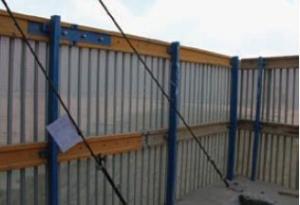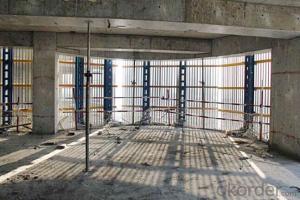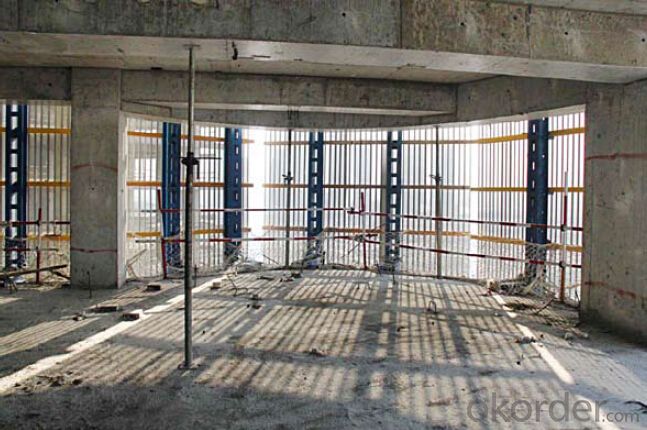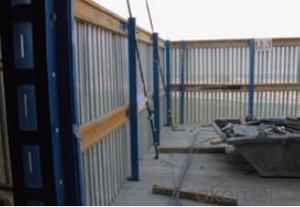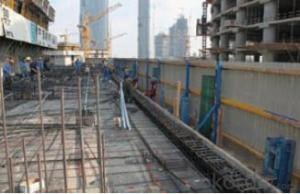Protection Platform for Formwork and scaffolding system
- Loading Port:
- Tianjin
- Payment Terms:
- TT OR LC
- Min Order Qty:
- 50 m²
- Supply Capability:
- 1000 m²/month
OKorder Service Pledge
OKorder Financial Service
You Might Also Like
Protection Platform PP-50
A kind of new type construction protection system, applying operating platform and safer job
location for construction corps.
Characteristics:
◆ Easy and quick assembling.
◆ Lifted as a group, it is rapid and economic.
◆ Auto-climbing
◆ A safe and reliable anchor system
1. Composition
2. Assembly process of anchor system
(1) Embed V-climbing cone and anchor plate into the slab.
(2) Fix anchor shoe on the slab by tensile bolt.
(3) The fixed anchor shoe.
◆ High work efficiency with work platform and unload platform
◆ High light transmittance with the hollow block
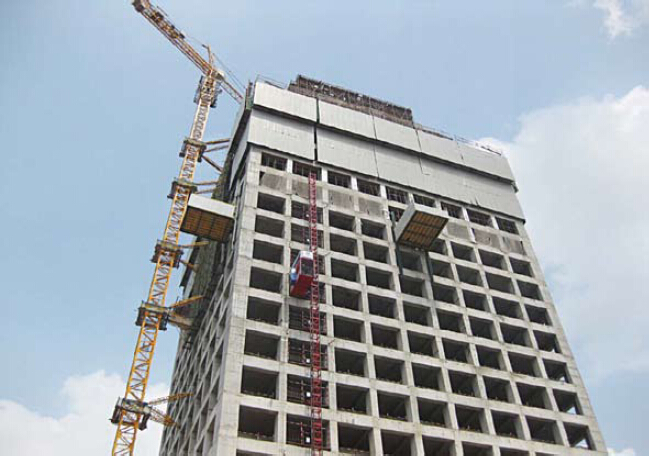

- Q: How does steel formwork contribute to the overall structural integrity of a building?
- Steel formwork contributes to the overall structural integrity of a building by providing a strong and rigid framework for pouring concrete. It ensures accurate alignment and dimensional stability, resulting in consistent and reliable construction. The use of steel formwork also enhances the load-bearing capacity of the structure, allowing it to withstand heavy loads and external forces. Additionally, steel formwork offers excellent durability and longevity, reducing the risk of structural failures over time.
- Q: How does steel formwork affect the overall project timeline?
- Steel formwork can have a positive impact on the overall project timeline. Its durability and reusability allow for faster and more efficient construction processes, reducing the time required for formwork installation and removal. Additionally, steel formwork often requires less maintenance and repairs compared to traditional wooden formwork, minimizing potential delays caused by formwork issues.
- Q: What are the considerations for designing steel formwork systems?
- When designing steel formwork systems, there are several important considerations that need to be taken into account. These considerations include: 1. Load-bearing capacity: Steel formwork systems must be designed to withstand the loads imposed by the concrete during pouring and curing. This includes the weight of the concrete, as well as any additional loads such as equipment or workers. 2. Safety: The safety of workers is of utmost importance when designing steel formwork systems. The system should be designed to provide a stable and secure working platform, with proper guardrails, access points, and fall protection measures. 3. Durability: Steel formwork systems should be designed to withstand the harsh conditions of construction sites, including exposure to weather elements, chemicals, and repeated use. The materials used should be corrosion-resistant and able to maintain their structural integrity over time. 4. Flexibility and adaptability: The design of the steel formwork system should allow for easy assembly, disassembly, and reusability. It should be adaptable to different project requirements and able to accommodate changes in design or construction methods. 5. Cost-effectiveness: The overall cost of the steel formwork system, including its initial investment, maintenance, and lifespan, should be considered. Designing a system that balances cost with performance and durability is essential. 6. Construction schedule: The design of the steel formwork system should take into account the construction schedule and the time required for assembly, concrete pouring, and formwork removal. The system should be designed to minimize downtime and facilitate efficient construction processes. 7. Environmental impact: Consideration should be given to the environmental impact of the steel formwork system, such as the use of sustainable materials, recycling options, and minimizing waste generation. Overall, designing steel formwork systems requires a comprehensive approach that takes into account structural integrity, safety, durability, flexibility, cost-effectiveness, construction schedule, and environmental factors. By considering these considerations, a well-designed steel formwork system can greatly contribute to the success of a construction project.
- Q: How does steel formwork improve the quality of concrete structures?
- Steel formwork improves the quality of concrete structures by providing a strong and durable framework that ensures accurate and precise shaping of the concrete. It offers better control over the dimensions and shape of the structure, resulting in a higher level of precision and consistency in the final product. Additionally, steel formwork has a smooth surface that reduces the chances of surface defects and improves the aesthetic appeal of the concrete structure.
- Q: Are there any specific maintenance requirements for steel formwork?
- Steel formwork has specific maintenance requirements that must be followed to ensure its optimal performance and durability. Cleaning the formwork after each use is crucial. This involves thoroughly removing any concrete residue and preventing the accumulation of corrosive agents. A mild detergent and water can be used for cleaning, followed by proper drying of all surfaces. Inspecting the formwork for any signs of damage or wear is also important. This includes checking for cracks, rust, or any other defects that could weaken the structure. Prompt repair or replacement of damaged components is necessary to maintain the formwork's integrity and safety. Proper storage and handling practices are essential for steel formwork maintenance. The formwork should be stored in a dry and well-ventilated area to prevent corrosion. Protection from moisture, extreme temperatures, and direct sunlight is necessary. When handling the formwork, abrasive materials or tools that could cause scratches or dents should be avoided. Regular lubrication of moving parts, such as hinges and locks, is recommended. This ensures smooth operation and prevents seizing or jamming. Using a suitable lubricant reduces friction and extends the life of these components. Lastly, it is advisable to follow the manufacturer's guidelines and recommendations for specific maintenance requirements of the steel formwork. These guidelines may include additional steps or precautions that are specific to the formwork system being used. By adhering to these maintenance requirements, steel formwork can be kept in excellent condition, allowing for efficient and safe construction practices.
- Q: How does steel formwork ensure accurate concrete dimensions and alignment?
- Steel formwork is a popular choice in construction projects due to its ability to ensure accurate concrete dimensions and alignment. This is achieved through various features and advantages offered by steel formwork. Firstly, steel formwork is highly durable and rigid, providing a stable structure for pouring and shaping concrete. Its strength prevents any deformation or movement during the pouring process, which is crucial for maintaining accurate dimensions and alignment. Unlike other formwork materials, such as wood, steel does not expand or contract significantly due to temperature changes or exposure to moisture, ensuring dimensional stability. In addition, steel formwork is designed and manufactured with precision, allowing for precise control over the shape, size, and alignment of the concrete structure. The use of computer-aided design (CAD) and advanced manufacturing techniques ensures that the steel formwork is accurately fabricated according to the required specifications. This precision eliminates any human errors in measurement and construction, resulting in accurate concrete dimensions and alignment. Furthermore, steel formwork offers flexibility in terms of customization. It can be easily adjusted and modified to accommodate various shapes, sizes, and architectural designs. This adaptability allows for accurate concrete dimensions and alignment, even for complex structures or intricate architectural elements. Moreover, steel formwork provides a smooth and level surface for the concrete to be poured against. This smoothness ensures that the concrete adheres uniformly to the formwork, preventing any irregularities or inconsistencies in the final structure. The tight joints and connections of steel formwork also minimize any leakage or seepage of concrete, ensuring that the poured material is contained within the desired dimensions. Overall, steel formwork ensures accurate concrete dimensions and alignment through its durability, precision, flexibility, and smoothness. By providing a stable and precise framework for pouring concrete, steel formwork eliminates any errors or deviations and guarantees a high-quality finished product.
- Q: How does steel formwork affect the overall durability of a construction project?
- Steel formwork can have a significant impact on the overall durability of a construction project. One of the key advantages of using steel formwork is its strength and durability. Steel is known for its high tensile strength, which allows it to withstand heavy loads and resist deformation. This strength is crucial in ensuring that the formwork maintains its shape and integrity throughout the construction process. Additionally, steel formwork is highly resistant to wear and tear, making it suitable for multiple uses and reuses. Unlike other materials such as wood, steel does not easily degrade or deteriorate, ensuring that the formwork remains in good condition for long periods. This durability is particularly important in large-scale construction projects that require repetitive formwork installations. Moreover, steel formwork offers excellent dimensional stability. It does not warp or shrink under varying weather conditions, which helps to maintain the accuracy and precision of the concrete structure being formed. This is crucial for ensuring that the final construction project meets the required specifications and standards. The durability of steel formwork also contributes to the overall safety of the construction project. Its strength and stability prevent any potential formwork failure, which could lead to accidents or structural damages during the concrete pouring process. By providing a secure and reliable support system, steel formwork enhances the safety of workers and the long-term structural integrity of the building. Furthermore, the durability of steel formwork translates into cost-effectiveness over the project's lifespan. Its ability to be reused reduces the need for constant replacement, saving time and money on material expenses. Additionally, the reduced maintenance required for steel formwork lowers ongoing maintenance costs, making it a cost-effective choice for construction projects. In conclusion, steel formwork greatly contributes to the overall durability of a construction project. Its strength, resistance to wear and tear, dimensional stability, and safety features ensure that the formwork remains intact throughout the construction process. This durability not only enhances the structural integrity of the building but also provides cost-effectiveness and peace of mind for the project stakeholders.
- Q: Can steel formwork be used for both large and small construction projects?
- Yes, steel formwork can be used for both large and small construction projects. Steel formwork offers several advantages such as durability, strength, and reusability, which make it suitable for a wide range of projects. For large construction projects, steel formwork provides the necessary structural support to handle heavy loads and withstand the pressures of large-scale construction. Additionally, its ability to be easily assembled and disassembled allows for efficient construction processes. On the other hand, for small construction projects, steel formwork offers cost-effectiveness and flexibility. Its reusability allows for multiple uses, minimizing the need for additional formwork materials and reducing construction costs. Overall, steel formwork is a versatile option that can be adapted to meet the requirements of both large and small construction projects.
- Q: How does steel formwork affect the overall energy efficiency of a building?
- Steel formwork can have a significant impact on the overall energy efficiency of a building. Firstly, steel formwork is known for its durability and longevity. This means that once the concrete is poured and the formwork is removed, the steel can be reused multiple times, reducing the need for new materials. The reuse of steel formwork reduces the energy and resources required for manufacturing new formwork, thereby reducing the embodied energy of the building. In addition, steel formwork offers better insulation properties compared to traditional timber formwork. This improved insulation helps to minimize heat transfer through the building envelope, reducing the energy consumption required for heating and cooling. The thermal mass of steel formwork can also help regulate temperatures within the building, leading to increased energy efficiency. Furthermore, steel formwork allows for precise and accurate construction, resulting in tighter joints and fewer air leaks. This enhances the building's overall air tightness, reducing the infiltration of outside air and improving the energy efficiency of the HVAC system. The reduced air leakage also contributes to better indoor air quality by preventing the entry of pollutants and allergens. Moreover, steel formwork can facilitate the integration of other sustainable technologies, such as renewable energy systems and advanced insulation materials. The strength and flexibility of steel allows for the incorporation of larger windows, which can maximize natural light and reduce the need for artificial lighting during the day. Overall, steel formwork positively affects the energy efficiency of a building by reducing embodied energy, improving insulation, enhancing air tightness, and enabling the integration of sustainable technologies. By choosing steel formwork, builders and developers can contribute to the long-term sustainability and energy efficiency of the built environment.
- Q: How does steel formwork handle construction joints?
- Steel formwork is a versatile and durable option for handling construction joints. It is specifically designed to handle the demands of construction joints and ensure a seamless and efficient construction process. Firstly, steel formwork is known for its strength and stability, which allows it to withstand the pressure and weight exerted on construction joints. This ensures that the formwork remains intact and in place, even when concrete is poured and compacted at the joints. Additionally, steel formwork is highly flexible and can be easily adjusted to accommodate various shapes and sizes of construction joints. This allows for precise and accurate placement of the formwork, ensuring that the joints are properly formed and aligned. Moreover, steel formwork is reusable, which makes it a cost-effective option for handling construction joints. Once the concrete has cured and the formwork is removed, it can be cleaned, repaired if necessary, and used again for subsequent construction projects. This reduces the need for additional formwork materials and minimizes waste. Furthermore, steel formwork provides a smooth and even surface finish, which is crucial for construction joints. It helps to prevent any leakage or seepage of concrete at the joints, ensuring that the structure remains watertight and structurally sound. In conclusion, steel formwork is an excellent choice for handling construction joints. Its strength, flexibility, reusability, and ability to provide a smooth surface finish make it a reliable and efficient solution for construction projects of all sizes and complexities.
Send your message to us
Protection Platform for Formwork and scaffolding system
- Loading Port:
- Tianjin
- Payment Terms:
- TT OR LC
- Min Order Qty:
- 50 m²
- Supply Capability:
- 1000 m²/month
OKorder Service Pledge
OKorder Financial Service
Similar products
Hot products
Hot Searches
Related keywords
